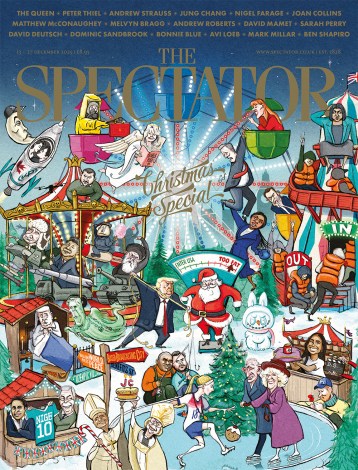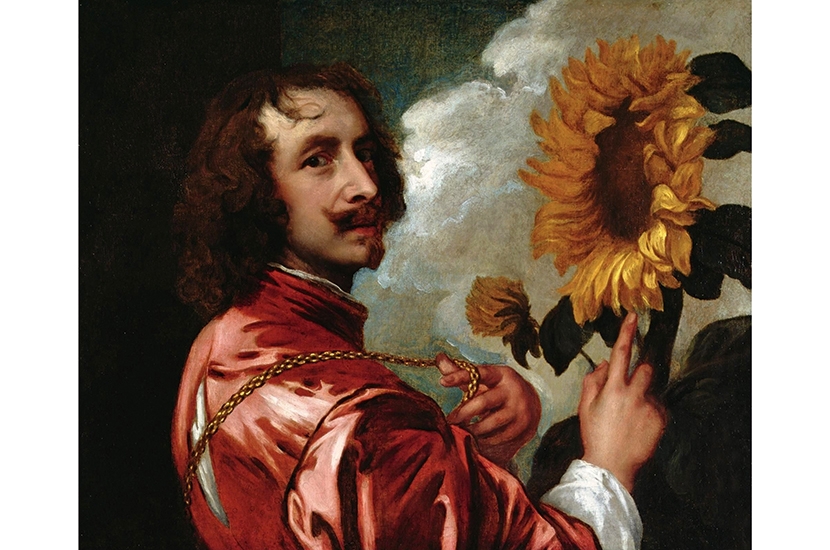Critics have argued over the meaning of the great golden flower head to which Van Dyck points in his ‘Self-Portrait with a Sunflower’. It probably symbolises the radiant majesty of the painter’s patron, Charles I, but for Van Gogh the sunflower ‘embodied and shouted out yellow, the colour of light, warmth and happiness’.
In the Victorian language of flowers the plant denoted pride or haughtiness, but its tendency to turn its head to the sun led Byron’s abject Julia to use its image on a seal for her final letter to Don Juan with the accompanying motto Elle vous suit partout. The sunflower has been adopted as an emblem by such diverse groups as the American women’s suffrage movement in 1896, the devoted followers of Chairman Mao in 1960s China and the Green Party in Germany in the 1980s. It is also the national flower of Ukraine, which not only grows some 15 million tonnes of sunflowers a year from which to extract a cooking oil low in saturated fat, but planted further ranks of them around the damaged Chernobyl nuclear reactor because they are highly effective in soaking up and eradicating radioactive contaminants. The cultural, symbolic and scientific properties of this single plant, one of 16 discussed, gives an indication of the imaginative reach of Kasia Boddy’s Blooming Flowers.
It’s hard to imagine Saffron Hill, the site of Fagin’s den, being a place where Crocus sativus was cultivated
Subtitled ‘A Seasonal History of Plants and People’, it is arranged in four sections — from spring to winter — each containing a general introduction and chapters on four individual species. Alongside essays on the lily, rose and poppy are investigations of less obvious plants, such as lotus, cotton and almond. Even among familiar flowers Boddy finds unexpected stories and connections. In discussing roses, she refreshingly highlights the flower’s sexual, rather than traditionally romantic, associations, from ‘the virginal promise of the closed rosebud’ in 16th-century poetry to gonorrhoea being dubbed ‘Saigon Rose… the prickliest rose of all’ during the Vietnam war. The chapter characteristically ends among Jean Genet’s beloved criminals in Miracle de la Rose and Un Chant d’Amour.
Similarly, we might be familiar with Oscar Wilde’s green carnation, but perhaps less well known is that the red carnation was a symbol of revolution in both Russia (1917) and Portugal (1974). It is also associated with Nikos Beloyannis, a member of the Greek Resistance in the second world war who was executed during a right-wing purge in 1952 and inspired Picasso to draw him as ‘L’homme à l’oeillet’. Though Boddy doesn’t say so, Picasso may well have been referring back to the many Renaissance portraits of young men holding a dianthus, where the flower tended to symbolise betrothal.
Among the generous selection of illustrations (which would have benefitted from being printed on better paper) is Marc Riboud’s justly famous photograph of a young woman student confronting a phalanx of the National Guard, bayonets drawn, outside the Pentagon in October 1967. Boddy observes that the flower the student is holding is a chrysanthemum — not for any particular associations but because it happened to be in season. The chrysanthemum is, however, the floral emblem of Japan, from where colourful and shaggy varieties were imported to Europe in the 1860s, grown and painted by Monet and Caillebotte. Oddly, although D.H. Lawrence crops up frequently elsewhere, no mention is made of his celebrated story ‘An Odour of Chrysanthemums’, nor is any explanation provided as to why these flowers are so often associated with death and funerals. Omissions are perhaps inevitable in such a book, but similarly Paul Nash might have been mentioned as an outstanding and unusual painter of sunflowers, imbuing them with mythical status as they eclipse the sun or bowl across the English landscape like giant runaway Catherine wheels.
Cotton and saffron are among plants selected by Boddy that are grown as crops but which also have a wide range of cultural associations. Historically allied to slavery, cotton was many centuries before used by the Hopi to cover the faces of their dead to ‘signify their future existence as Cloud People’. The cotton plant also gave rise in the 14th century to Sir John Mandeville’s fanciful account of a tree bearing baby lambs at the end of branches ‘so pliable that they bent down to allow the lambs to feed when they are hungrie’.
While it is well know how Saffron Walden got its name, it’s hard to imagine Saffron Hill in London, chiefly notorious as the site of Fagin’s den in Oliver Twist, being another place where Crocus sativus was once cultivated, in the extensive gardens of the Bishop of Ely. Not everyone, while adding saffron to their risotto Milanese, will be pleased to have learned that because of it rich yellow colour the spice was once used to treat both diseases of the urinary tract and moulting canaries; but for those who like curious botanical facts this lively and well-researched book is a garland of delights.






Comments